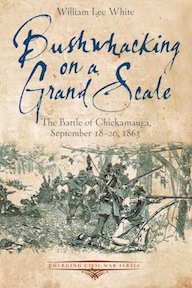The “Emerging Civil War Series” Series: Bushwhacking on a Grand Scale
 When I began to write the story of the battle of Chickamauga in what became Bushwhacking on a Grand Scale, it presented a unique challenge as it was one that I had told a thousand times, either on battlefield tours or in presentations for Civil War Roundtables, etc. I decided the route I would take was to write a book that would serve the dual function of telling the story in a way that would appeal to both those who had never read a thing about the battle, but also would appeal to a veteran battlefield tramper.
When I began to write the story of the battle of Chickamauga in what became Bushwhacking on a Grand Scale, it presented a unique challenge as it was one that I had told a thousand times, either on battlefield tours or in presentations for Civil War Roundtables, etc. I decided the route I would take was to write a book that would serve the dual function of telling the story in a way that would appeal to both those who had never read a thing about the battle, but also would appeal to a veteran battlefield tramper.
To achieve this, I decided to address one of the most common issues I have heard about how to deal with the confusion of the battle, with so many events going on here and there, etc. To this end, I used the idea that Chickamauga was actually several small battles occurring simultaneously or one leading to the other. This worked well for both the narrative as well as for the tour element that the book offered.
The next thing I wanted to do was try to tackle the myths of the battle—stories that had been told so many times that they have become accepted as fact by many general histories of the war. I tackled things like the story of how the gap was opened in the center of the line on September 20, the leadership of General Bragg, etc. I wanted to provide some new insights and fresh perspectives on these things.
Finally, the other objective, and one that ultimately meant the most to me, was to share some “new” stories, to use the voices of men who were there, but whose stories had not been used before, or at the least ones that were barely touched upon (so, no Sam Watkins). This is actually what I enjoyed the most about the book, bringing these tales out to give voice to these men. It was also while working on this aspect that I actually discovered some new accounts—something that has continued to this day—and some of which really came to mean a lot to me. One such story was that of Sgt. Jacob Lair of the 75th Indiana who, during the fighting on September 19, carried a wounded comrade and both his regiment’s national and regimental colors off the battlefield before the attacking Confederates of General A.P. Stewart’s division. This man deserved a Medal of Honor, but not even a photograph is known of him.
Putting these stories into the narrative is what I think is one of the best points of Bushwhacking—telling the story of the battle as a soldier’s fight. I hope that I achieved that goal.
* * *
Editor’s Note (from Chris):
Bushwhacking was the first ECWS book not written by Kris and me, and it was the first book from the Western Theater. We were pretty stoked about it—so much so that I drove to Chickamauga to spend a day taking pictures for the book with Lee.
Wow.
I’d never met Lee in person before, although he’d been contributing to the blog since our first year. It was nice to meet him in person and let him show off his stuff on his home battlefield—and Chickamauga was literally his home battlefield. As he explains in an appendix in the book, he grew up locally, and Chickamauga was his “first” battlefield. That he eventually came back there was a homecoming for him in the most literal of ways.
When we got out onto the field, Lee dazzled me with his knowledge of the battle and battlefield. Lee is one of those rare guys who can tell you how many guys were in a regiment on a particular day, what their colonel’s middle name was, what the colonel’s shoe size was, and where the colonel’s wife went to grammar school. I’ve only met a few historians who have that kind of memory. Kris White is one. Frank O’Reilly is another. Ed Bearss. And Lee White. That’s heady company. Lee was absolutely amazing.
When I remarked on that to him, he kind of shrugged it off. “That’s not even really the stuff that I’m particularly interested in,” he admitted. “I like the stories of the individual soldiers.” Lee came to history through his experience reenacting, and that gave him a real passion for the experience of the common soldier. He loved the human element. When he wrote Bushwhacking, he really wanted to make sure that came through.
My day on the battlefield taking pictures with Lee was one of the most memorable battlefield experiences I’ve had in a career of incredible battlefield experiences. I’m grateful I had the chance to spend the day with him in the field, and I hope we accurately captured the fruits of his work in the book.
————
Bushwhacking on a Grand Scale: The Battle of Chickamauga, September 18-20, 1863
by William Lee White
Savas Beatie, 2013
Click here to read more about the book, including a book description, reviews, and author bio.

1 Response to The “Emerging Civil War Series” Series: Bushwhacking on a Grand Scale